Electronic Commerce Strategies: Smartphone Industry Analysis Report
VerifiedAdded on 2022/11/11
|7
|1418
|204
Report
AI Summary
This report provides an in-depth analysis of electronic commerce strategies within the rapidly evolving smartphone industry. It examines the key players, including Samsung, Apple, Huawei, and Oppo, and their approaches to mobile connectivity, device design, and application development. The report highlights the importance of 5G technology, foldable smartphones, and advanced camera features as critical differentiators. It explores the impact of mobile apps on e-commerce, citing examples like Amazon and Walmart, and contrasts the operating systems of iOS and Android. The analysis covers the marketing strategies employed by these companies, including advertising, pricing, and distribution channels, while also addressing the challenges posed by emerging competitors. The report concludes by summarizing the dynamic nature of the smartphone market and the strategies used to maintain a competitive edge.
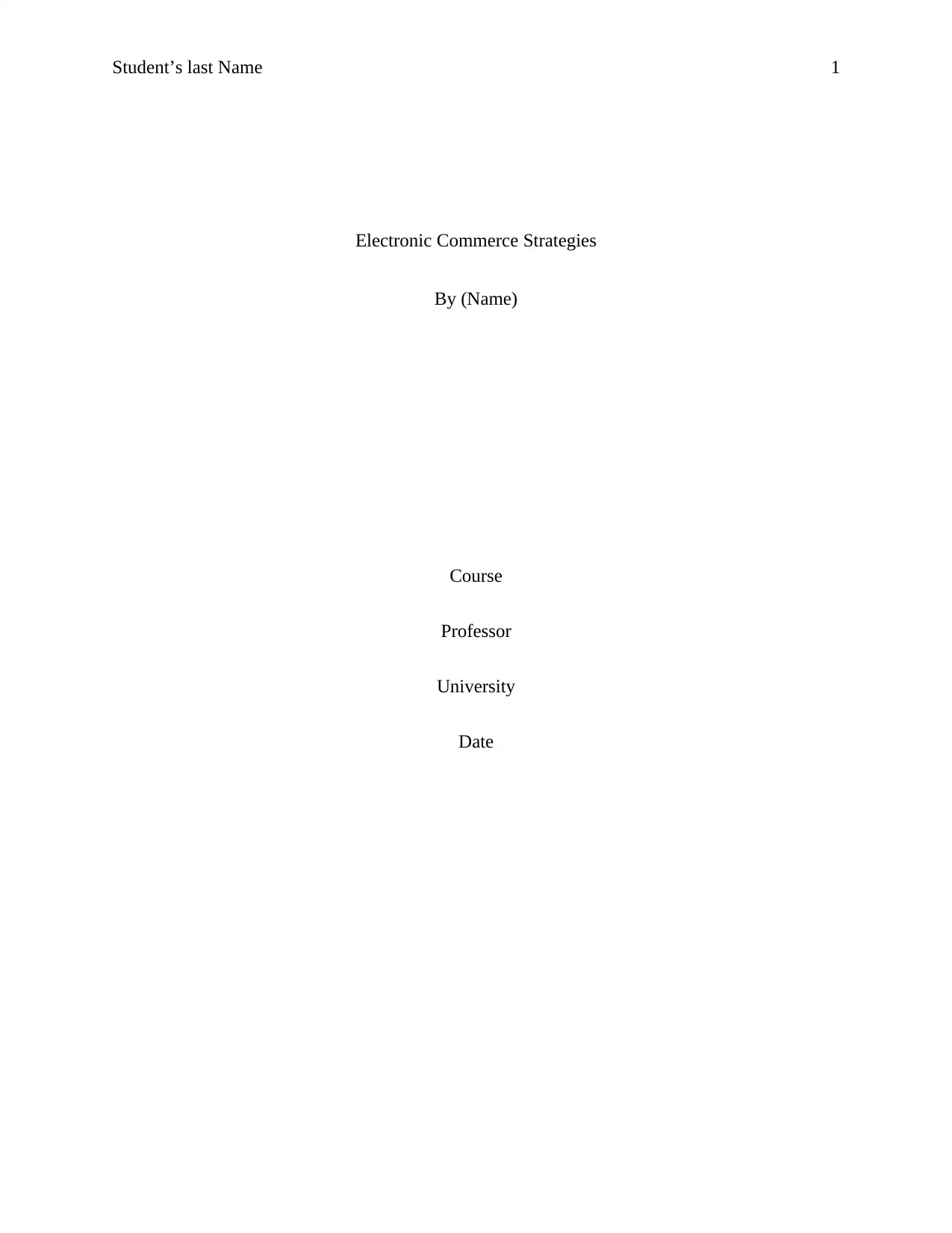
Student’s last Name 1
Electronic Commerce Strategies
By (Name)
Course
Professor
University
Date
Electronic Commerce Strategies
By (Name)
Course
Professor
University
Date
Paraphrase This Document
Need a fresh take? Get an instant paraphrase of this document with our AI Paraphraser
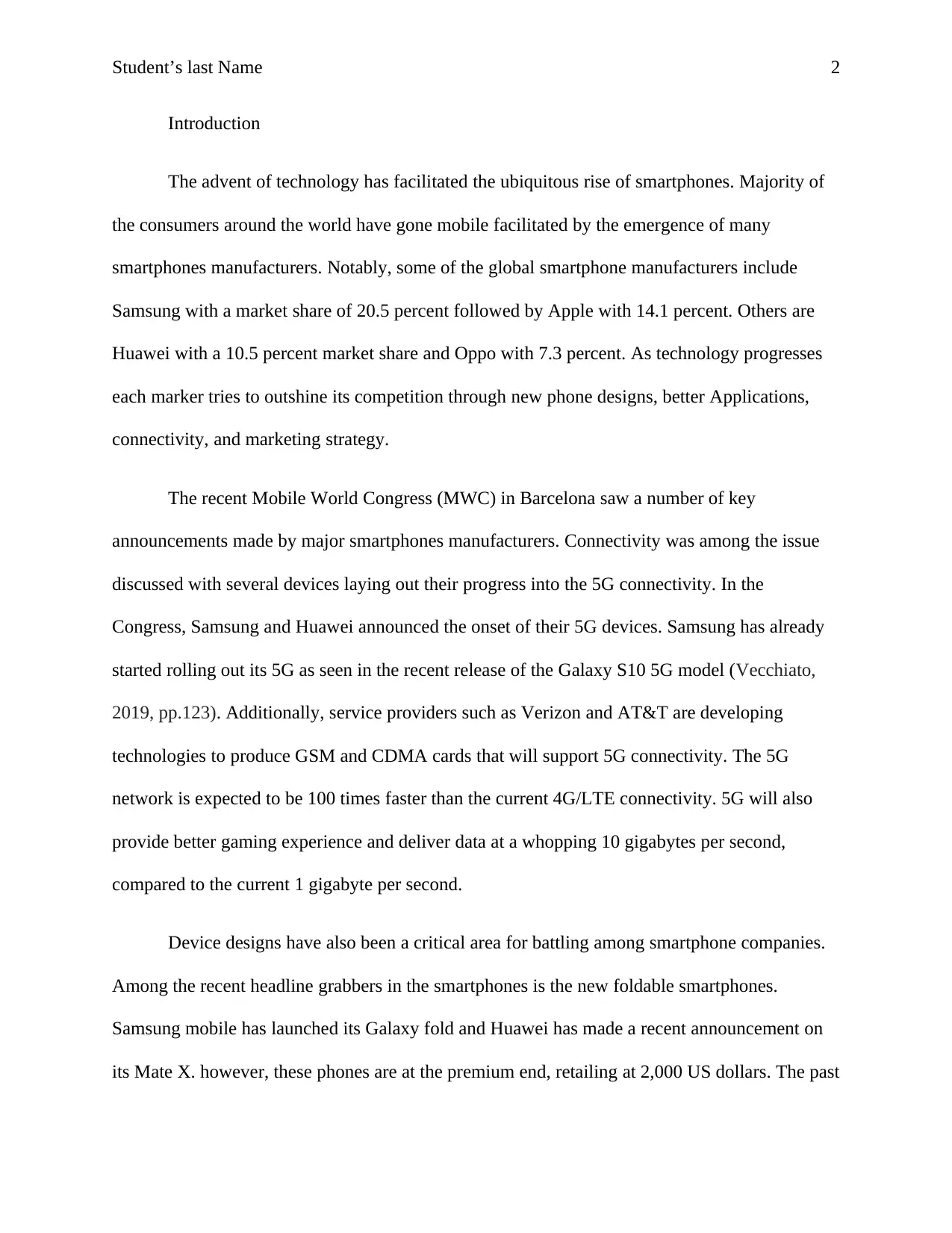
Student’s last Name 2
Introduction
The advent of technology has facilitated the ubiquitous rise of smartphones. Majority of
the consumers around the world have gone mobile facilitated by the emergence of many
smartphones manufacturers. Notably, some of the global smartphone manufacturers include
Samsung with a market share of 20.5 percent followed by Apple with 14.1 percent. Others are
Huawei with a 10.5 percent market share and Oppo with 7.3 percent. As technology progresses
each marker tries to outshine its competition through new phone designs, better Applications,
connectivity, and marketing strategy.
The recent Mobile World Congress (MWC) in Barcelona saw a number of key
announcements made by major smartphones manufacturers. Connectivity was among the issue
discussed with several devices laying out their progress into the 5G connectivity. In the
Congress, Samsung and Huawei announced the onset of their 5G devices. Samsung has already
started rolling out its 5G as seen in the recent release of the Galaxy S10 5G model (Vecchiato,
2019, pp.123). Additionally, service providers such as Verizon and AT&T are developing
technologies to produce GSM and CDMA cards that will support 5G connectivity. The 5G
network is expected to be 100 times faster than the current 4G/LTE connectivity. 5G will also
provide better gaming experience and deliver data at a whopping 10 gigabytes per second,
compared to the current 1 gigabyte per second.
Device designs have also been a critical area for battling among smartphone companies.
Among the recent headline grabbers in the smartphones is the new foldable smartphones.
Samsung mobile has launched its Galaxy fold and Huawei has made a recent announcement on
its Mate X. however, these phones are at the premium end, retailing at 2,000 US dollars. The past
Introduction
The advent of technology has facilitated the ubiquitous rise of smartphones. Majority of
the consumers around the world have gone mobile facilitated by the emergence of many
smartphones manufacturers. Notably, some of the global smartphone manufacturers include
Samsung with a market share of 20.5 percent followed by Apple with 14.1 percent. Others are
Huawei with a 10.5 percent market share and Oppo with 7.3 percent. As technology progresses
each marker tries to outshine its competition through new phone designs, better Applications,
connectivity, and marketing strategy.
The recent Mobile World Congress (MWC) in Barcelona saw a number of key
announcements made by major smartphones manufacturers. Connectivity was among the issue
discussed with several devices laying out their progress into the 5G connectivity. In the
Congress, Samsung and Huawei announced the onset of their 5G devices. Samsung has already
started rolling out its 5G as seen in the recent release of the Galaxy S10 5G model (Vecchiato,
2019, pp.123). Additionally, service providers such as Verizon and AT&T are developing
technologies to produce GSM and CDMA cards that will support 5G connectivity. The 5G
network is expected to be 100 times faster than the current 4G/LTE connectivity. 5G will also
provide better gaming experience and deliver data at a whopping 10 gigabytes per second,
compared to the current 1 gigabyte per second.
Device designs have also been a critical area for battling among smartphone companies.
Among the recent headline grabbers in the smartphones is the new foldable smartphones.
Samsung mobile has launched its Galaxy fold and Huawei has made a recent announcement on
its Mate X. however, these phones are at the premium end, retailing at 2,000 US dollars. The past

Student’s last Name 3
smartphone's design has also received significant shift with iPhone pioneering the edge-edge
screen bezel on its iPhone x device. Additionally, Apple in 2017 shifted from its fingerprint
sensor and introduced face recognition technology whereby users have to just look at the phones
to unlock the devices. The battle of devices has been over the years between the two giants that
are iPhone and Samsung. Samsung uses OLED screen technology and Apple relies on the retina
display (Cecere, Corrocher and Battaglia, 2015, pp.170). Additionally. Other notable devices
features include personal assistants such as Siri by Apple, Bixby and Google voice. The
capabilities of a smartphone camera have increasingly become a selling point for smartphone
devices. The era of social media facilitated the advent of camera technologies (Tseng, Liu and
Wu, 2014, pp.52). Oppo has pioneered the smartphone sector with selfie phones with the latest
Oppo f-11 pro having a 40-megapixel camera. Huawei p30 has 3 camera lenses using Leica
technology. These cameras work mutually to improve the quality of the image and prevent frisky
images as a result of shaking.
Apple App store was developed in 2008 and at that time there were only 800 apps for
download. In 2019, there are well over 3,500,000 across both Android and iOS platforms. The
rise of smartphones has facilitated the growth of mobile apps. Some of the apps are for
personalization of device, entertainment such as Netflix, educational, and work-related. Mobile
apps have also facilitated e-commerce (Gikas and Grant, 2013, pp.22). The retail industry has
seen an increase of 200 percent in sale due to mobile apps. Amazon and Walmart are examples
of retailers that are benefiting from e-commerce based applications. In the smartphone industry
there exist two mostly used operating system that is iOS and Android. iOS is used by Apple and
Android by Samsung. Huawei, and Oppo. Android is a third party software provided by Google
(Yeh, Wang and Yieh, 2016, pp.249). Apple applications have a better user interface as both the
smartphone's design has also received significant shift with iPhone pioneering the edge-edge
screen bezel on its iPhone x device. Additionally, Apple in 2017 shifted from its fingerprint
sensor and introduced face recognition technology whereby users have to just look at the phones
to unlock the devices. The battle of devices has been over the years between the two giants that
are iPhone and Samsung. Samsung uses OLED screen technology and Apple relies on the retina
display (Cecere, Corrocher and Battaglia, 2015, pp.170). Additionally. Other notable devices
features include personal assistants such as Siri by Apple, Bixby and Google voice. The
capabilities of a smartphone camera have increasingly become a selling point for smartphone
devices. The era of social media facilitated the advent of camera technologies (Tseng, Liu and
Wu, 2014, pp.52). Oppo has pioneered the smartphone sector with selfie phones with the latest
Oppo f-11 pro having a 40-megapixel camera. Huawei p30 has 3 camera lenses using Leica
technology. These cameras work mutually to improve the quality of the image and prevent frisky
images as a result of shaking.
Apple App store was developed in 2008 and at that time there were only 800 apps for
download. In 2019, there are well over 3,500,000 across both Android and iOS platforms. The
rise of smartphones has facilitated the growth of mobile apps. Some of the apps are for
personalization of device, entertainment such as Netflix, educational, and work-related. Mobile
apps have also facilitated e-commerce (Gikas and Grant, 2013, pp.22). The retail industry has
seen an increase of 200 percent in sale due to mobile apps. Amazon and Walmart are examples
of retailers that are benefiting from e-commerce based applications. In the smartphone industry
there exist two mostly used operating system that is iOS and Android. iOS is used by Apple and
Android by Samsung. Huawei, and Oppo. Android is a third party software provided by Google
(Yeh, Wang and Yieh, 2016, pp.249). Apple applications have a better user interface as both the
⊘ This is a preview!⊘
Do you want full access?
Subscribe today to unlock all pages.

Trusted by 1+ million students worldwide
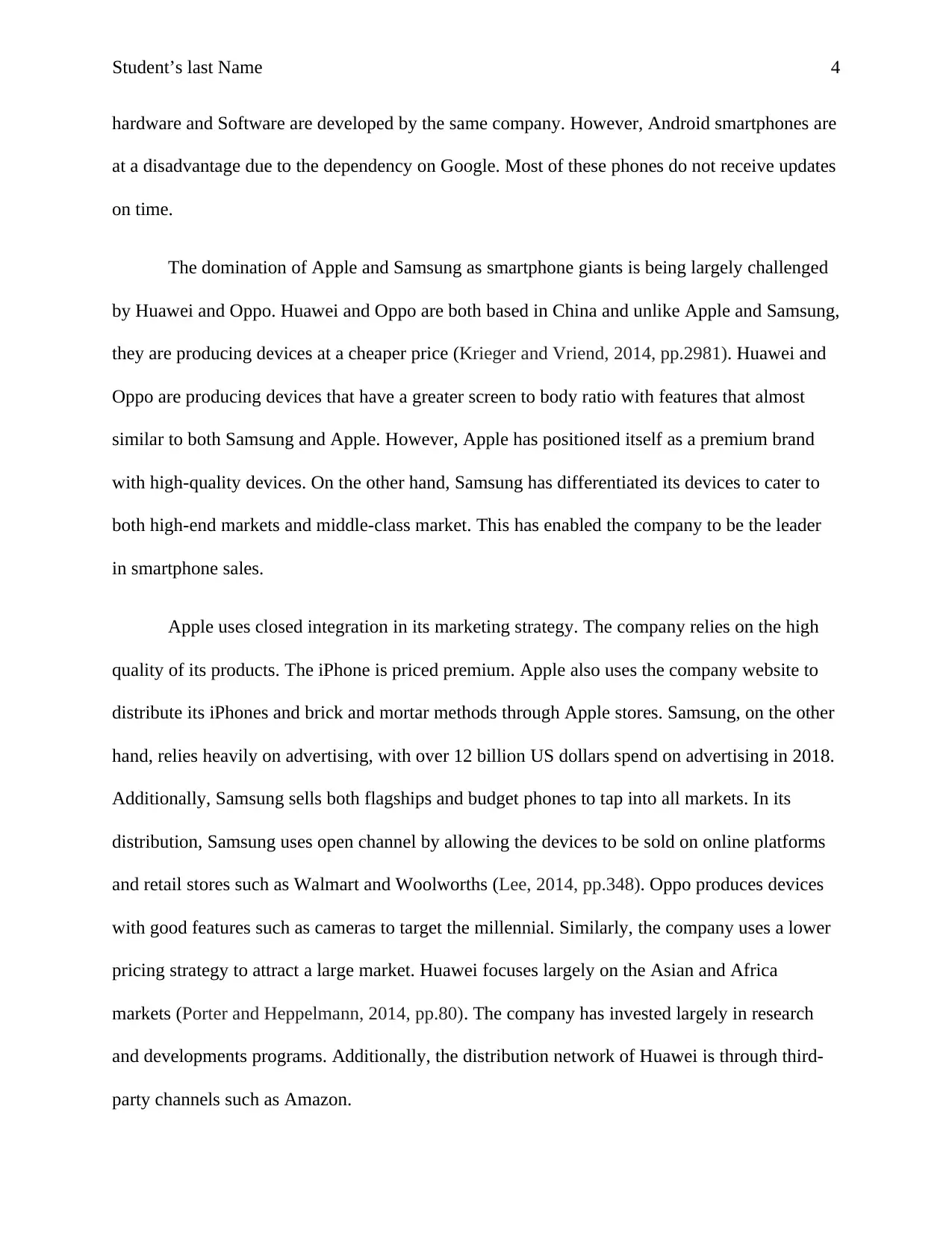
Student’s last Name 4
hardware and Software are developed by the same company. However, Android smartphones are
at a disadvantage due to the dependency on Google. Most of these phones do not receive updates
on time.
The domination of Apple and Samsung as smartphone giants is being largely challenged
by Huawei and Oppo. Huawei and Oppo are both based in China and unlike Apple and Samsung,
they are producing devices at a cheaper price (Krieger and Vriend, 2014, pp.2981). Huawei and
Oppo are producing devices that have a greater screen to body ratio with features that almost
similar to both Samsung and Apple. However, Apple has positioned itself as a premium brand
with high-quality devices. On the other hand, Samsung has differentiated its devices to cater to
both high-end markets and middle-class market. This has enabled the company to be the leader
in smartphone sales.
Apple uses closed integration in its marketing strategy. The company relies on the high
quality of its products. The iPhone is priced premium. Apple also uses the company website to
distribute its iPhones and brick and mortar methods through Apple stores. Samsung, on the other
hand, relies heavily on advertising, with over 12 billion US dollars spend on advertising in 2018.
Additionally, Samsung sells both flagships and budget phones to tap into all markets. In its
distribution, Samsung uses open channel by allowing the devices to be sold on online platforms
and retail stores such as Walmart and Woolworths (Lee, 2014, pp.348). Oppo produces devices
with good features such as cameras to target the millennial. Similarly, the company uses a lower
pricing strategy to attract a large market. Huawei focuses largely on the Asian and Africa
markets (Porter and Heppelmann, 2014, pp.80). The company has invested largely in research
and developments programs. Additionally, the distribution network of Huawei is through third-
party channels such as Amazon.
hardware and Software are developed by the same company. However, Android smartphones are
at a disadvantage due to the dependency on Google. Most of these phones do not receive updates
on time.
The domination of Apple and Samsung as smartphone giants is being largely challenged
by Huawei and Oppo. Huawei and Oppo are both based in China and unlike Apple and Samsung,
they are producing devices at a cheaper price (Krieger and Vriend, 2014, pp.2981). Huawei and
Oppo are producing devices that have a greater screen to body ratio with features that almost
similar to both Samsung and Apple. However, Apple has positioned itself as a premium brand
with high-quality devices. On the other hand, Samsung has differentiated its devices to cater to
both high-end markets and middle-class market. This has enabled the company to be the leader
in smartphone sales.
Apple uses closed integration in its marketing strategy. The company relies on the high
quality of its products. The iPhone is priced premium. Apple also uses the company website to
distribute its iPhones and brick and mortar methods through Apple stores. Samsung, on the other
hand, relies heavily on advertising, with over 12 billion US dollars spend on advertising in 2018.
Additionally, Samsung sells both flagships and budget phones to tap into all markets. In its
distribution, Samsung uses open channel by allowing the devices to be sold on online platforms
and retail stores such as Walmart and Woolworths (Lee, 2014, pp.348). Oppo produces devices
with good features such as cameras to target the millennial. Similarly, the company uses a lower
pricing strategy to attract a large market. Huawei focuses largely on the Asian and Africa
markets (Porter and Heppelmann, 2014, pp.80). The company has invested largely in research
and developments programs. Additionally, the distribution network of Huawei is through third-
party channels such as Amazon.
Paraphrase This Document
Need a fresh take? Get an instant paraphrase of this document with our AI Paraphraser

Student’s last Name 5
Conclusion
The foregone are some of the strategies used by smartphone manufacturers to position
themselves strategically in the market. The smartphone industry grows at a very fast pace with
the developers and manufacturers coming up with new designs and better connectivity to attract
the consumer. Additionally, the companies are re-evaluating their business model to adapt
activities such as advertising and sports sponsorship to propel their brands to international
heights.
Conclusion
The foregone are some of the strategies used by smartphone manufacturers to position
themselves strategically in the market. The smartphone industry grows at a very fast pace with
the developers and manufacturers coming up with new designs and better connectivity to attract
the consumer. Additionally, the companies are re-evaluating their business model to adapt
activities such as advertising and sports sponsorship to propel their brands to international
heights.
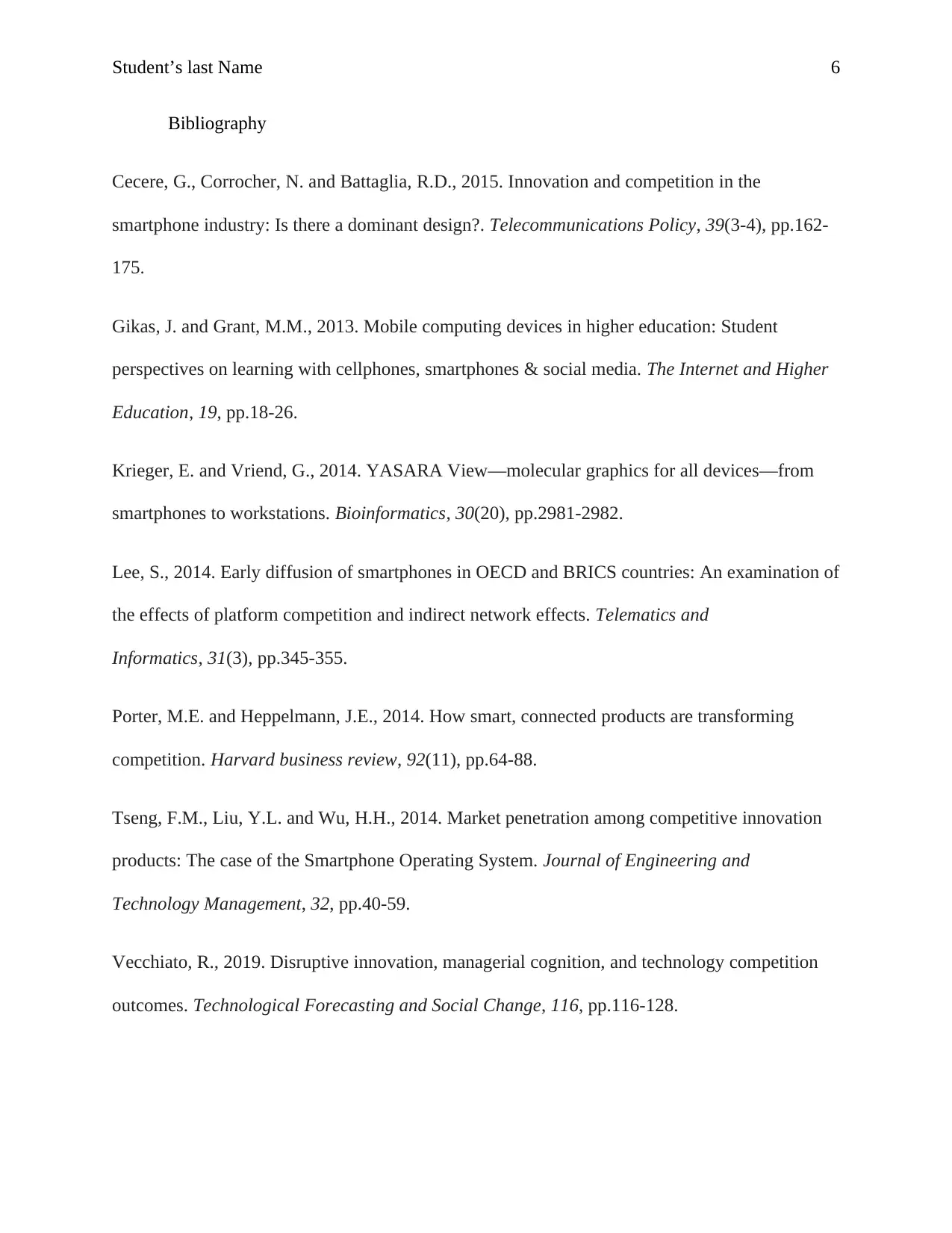
Student’s last Name 6
Bibliography
Cecere, G., Corrocher, N. and Battaglia, R.D., 2015. Innovation and competition in the
smartphone industry: Is there a dominant design?. Telecommunications Policy, 39(3-4), pp.162-
175.
Gikas, J. and Grant, M.M., 2013. Mobile computing devices in higher education: Student
perspectives on learning with cellphones, smartphones & social media. The Internet and Higher
Education, 19, pp.18-26.
Krieger, E. and Vriend, G., 2014. YASARA View—molecular graphics for all devices—from
smartphones to workstations. Bioinformatics, 30(20), pp.2981-2982.
Lee, S., 2014. Early diffusion of smartphones in OECD and BRICS countries: An examination of
the effects of platform competition and indirect network effects. Telematics and
Informatics, 31(3), pp.345-355.
Porter, M.E. and Heppelmann, J.E., 2014. How smart, connected products are transforming
competition. Harvard business review, 92(11), pp.64-88.
Tseng, F.M., Liu, Y.L. and Wu, H.H., 2014. Market penetration among competitive innovation
products: The case of the Smartphone Operating System. Journal of Engineering and
Technology Management, 32, pp.40-59.
Vecchiato, R., 2019. Disruptive innovation, managerial cognition, and technology competition
outcomes. Technological Forecasting and Social Change, 116, pp.116-128.
Bibliography
Cecere, G., Corrocher, N. and Battaglia, R.D., 2015. Innovation and competition in the
smartphone industry: Is there a dominant design?. Telecommunications Policy, 39(3-4), pp.162-
175.
Gikas, J. and Grant, M.M., 2013. Mobile computing devices in higher education: Student
perspectives on learning with cellphones, smartphones & social media. The Internet and Higher
Education, 19, pp.18-26.
Krieger, E. and Vriend, G., 2014. YASARA View—molecular graphics for all devices—from
smartphones to workstations. Bioinformatics, 30(20), pp.2981-2982.
Lee, S., 2014. Early diffusion of smartphones in OECD and BRICS countries: An examination of
the effects of platform competition and indirect network effects. Telematics and
Informatics, 31(3), pp.345-355.
Porter, M.E. and Heppelmann, J.E., 2014. How smart, connected products are transforming
competition. Harvard business review, 92(11), pp.64-88.
Tseng, F.M., Liu, Y.L. and Wu, H.H., 2014. Market penetration among competitive innovation
products: The case of the Smartphone Operating System. Journal of Engineering and
Technology Management, 32, pp.40-59.
Vecchiato, R., 2019. Disruptive innovation, managerial cognition, and technology competition
outcomes. Technological Forecasting and Social Change, 116, pp.116-128.
⊘ This is a preview!⊘
Do you want full access?
Subscribe today to unlock all pages.

Trusted by 1+ million students worldwide
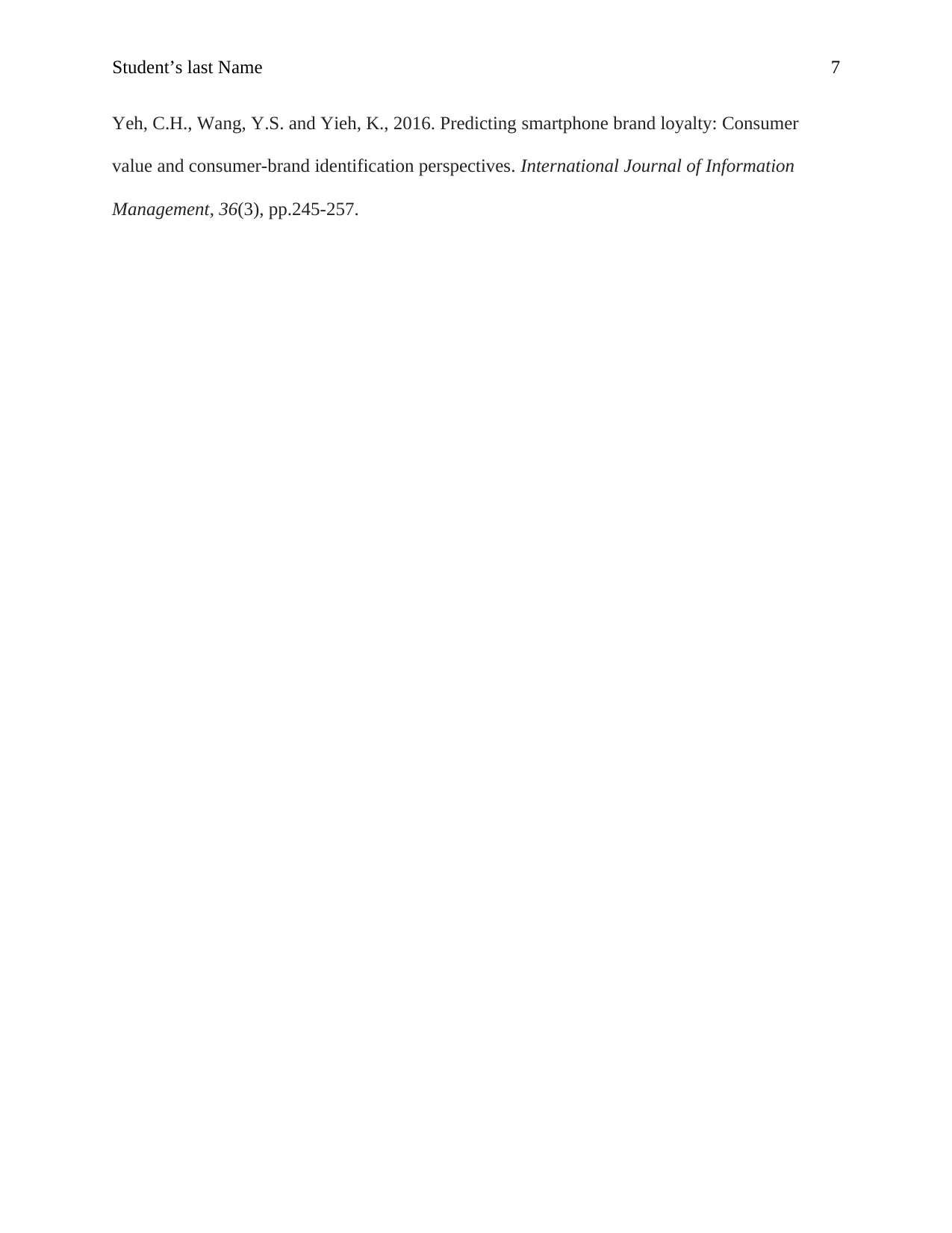
Student’s last Name 7
Yeh, C.H., Wang, Y.S. and Yieh, K., 2016. Predicting smartphone brand loyalty: Consumer
value and consumer-brand identification perspectives. International Journal of Information
Management, 36(3), pp.245-257.
Yeh, C.H., Wang, Y.S. and Yieh, K., 2016. Predicting smartphone brand loyalty: Consumer
value and consumer-brand identification perspectives. International Journal of Information
Management, 36(3), pp.245-257.
1 out of 7
Your All-in-One AI-Powered Toolkit for Academic Success.
+13062052269
info@desklib.com
Available 24*7 on WhatsApp / Email
![[object Object]](/_next/static/media/star-bottom.7253800d.svg)
Unlock your academic potential
Copyright © 2020–2025 A2Z Services. All Rights Reserved. Developed and managed by ZUCOL.
